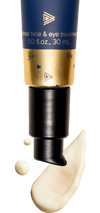Head over to How to Combine Actives Like a Pro Pt 2 for more. Shopping for a "big 4" product? Checkout community-favorite products here.
Finding that first effective ingredient that makes a visible difference to your skin is a bit like opening pandora’s box. Encouraged, you probably can’t wait to get your hands on all the top of the line actives on the market. But wait! Not every combination works and turns out the relationship can be complicated. So let’s figure out how to combine and handle skincare actives with confidence.
Skincare actives interactions can look a bit like a trashy reality TV relationship map. Let’s start with the Big 4 of Actives: L-ascorbic acid (Vitamin C), AHAs ( glycolic, lactic, and mandelic acid), niacinamide, and retinol.
Actives Relationship Map

As you can see, in this crude breakdown, it can get confusing even with just 4 actives, so let’s walk through the map together!
1. L-ascorbic acid + Niacinamide - Relationship Status: It’s complicated.
If you do some digging on the interwebs, you’ll soon find many articles telling you to avoid this combination because of the resulting dreaded yellow complex. In a nutshell, this combined niacinamide ascorbate complex is still effective for skincare. However, for optimal efficacy, we would still exercise caution with products that formulate the 2 together. Reason being, ascorbic acid needs to be in a formula with low pH of 3.5, but intrinsically niacinamide would raise that pH up closer to the 4.5, 5 range without further adjustments. So again, this combo isn’t harmful but there are some steps needed to use these two ingredients together more effectively.
2. Niacnamide + Retinol - Relationship Status: The love is real!
Unfortunately, your reliable neighborhood anti-aging superstar retinol can come with a bit of a mean streak due to its irritation potential. Niacinamide can actually help decrease retinol irritation, and on top of that, it can bolster your skin barrier
3. Retinol + AHAs - Relationship Status: Volatile! Proceed with caution.
These two are both known for effectively increasing cell turnover. We wouldn’t recommend using them together in the same night routine. Um hellooo over-exfoliation! If your skin responds well to both of these, at most we would recommend alternating nights with these two.
4. AHAs + L-ascorbic acid - Relationship Status: Perfect for each other and they know it.
These work around the same pH level and can be layered. While it’s best to leave AHAs for night use, but you can use L-AA both day and night. So if you would like to layer the two, bundle these two for your night routine.
5. L-ascorbic acid + Retinol - Relationship Status: Better as long-distance friends.
Retinol pH needs to be at a higher level (pH~5.5) which doesn’t go well with L-ascorbic’s needs for a pH of 3.5. The best way to have both in your life is to use L-AA during the day and retinol at night. They're just better apart.
Layering Order (Team Water vs Team Oil)
When creating your own layering cocktail, it’s important to consider the layering order. A good rule of thumb to live by is to follow which team (oil or water) the ingredient bats for. Team water ingredients should generally go on before team oil ingredients for the best chance of absorption. As a quick review:
- Niacinamide: Team water
- L-ascorbic acid: Team water
- AHA: Team water (sometimes both)
- BHA: salicylic acid sorta bats for both teams
- Retinol: Team oil
- Vitamin E: Team oil
- Ceramides: Team oil
Wait Time
The other million dollar question to your layering game is the “20 minute wait time” question. Usually, the reason cited is to avoid different pH levels of the products to “cancel out” each other. In some unrelated studies, we find that if a product affects your skin pH, it takes WAY longer than 20 minutes for skin pH to go back to the usual 5.5 (think more like 2 hours). Real talk, ain’t nobody got time to wait 2 hours to put on the next skin product.
For this reason, we wouldn't worry too much about the different pHs except for the AHA/retinol scenario. Like we said, just alternate if you really are trying to work in both.
Takeaway
Layering and combining skincare actives can be complicated. Finding your core daily routine and building on top of it by carefully experimenting can pay off big time!
For example, Gloria doesn’t respond super well to retinol. So her typical go to is L-AA for day and AHA for night. Once in a while though, she will reintroduce retinol back into her life on an every other day basis, and NOT in conjunction with AHAs.
Meanwhile, Victoria … is a simple soul and likes putting less stuff on her face (*cough...also lazy). While she does use L-AA daily, she'll add three nights of a high dose retinol a week and just follow up with a moisturizer.
Was the actives relationship map helpful? Want us to build it out to include say kojic acid, peptides and more? Check out some of our layering tips in Combine Skincare Actives Like a Pro Pt 2!







